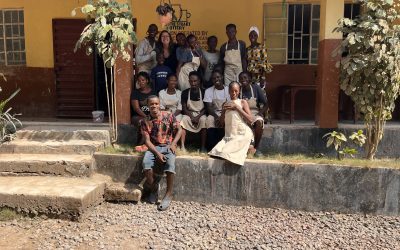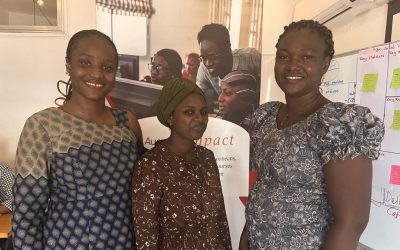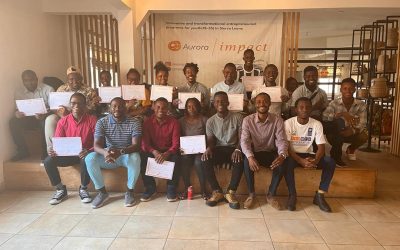We waited anxiously at the check-in desk at London’s Heathrow Airport, eight men and women on our way to Freetown, Sierra Leone, early in November. The tension rose a notch when we were informed that our flight was overbooked, but we turned down the offer of an extra day in London along with a tidy sum to spend in the shops. Our tight schedule for the following day had taken months of careful planning, and we desperately wanted to reach our destination.
Our group was made up of the board members and managing director of Aurora, along with the Director of UNICEF in Iceland.
Aurora sponsors a range of educational projects in Sierra Leone in partnership with UNICEF and the country’s education authorities. Our group was on the way to West Africa to see at first hand how some of the projects were progressing. We wanted to see what had been accomplished and visit some of the schools that had been established using grants from the fund. We also wanted to see some of the new projects proposed by aid agencies and, in some cases, by individuals.
Dozens of schools have opened all around the country with financial assistance from the founders of the Aurora Foundation. Early efforts concentrated on building schools, mostly in remote parts of the country where they were desperately needed following the devastation wreaked during the civil war that divided the country from 1991 to 2002.
In 2007, Ólafur Ólafsson and his wife Ingibjörg made donations that helped build 50 schools. The following year, they established the Foundation, which has since given grants for educational projects. The Foundation decided to concentrate its efforts in a single region, and chose Kono District, in the east of the country on the border with neighbouring Guinea. This area is home to Sierra Leone’s largest diamond mine, which led to widespread destruction during the civil war.
The emphasis is now on improving the quality of schooling and meeting the needs of the children, especially girls. Rather than building more schools, the Foundation is focusing more on teacher training and educating the educators in child-centred teaching. Every school now has a mothers club and a school management committee. One of the functions of the mothers clubs is to help mothers in the community to understand the importance of education and encourage them to monitor and support their school-age daughters. The mothers are defenders of their children’s rights, and they play a vital role when cases of sexual assault or abuse arise. They have to keep track of the process and ensure that the authorities are informed.
The school management committees are in many ways similar to parent associations. Their purpose is to give the community more responsibility for running the schools. They are responsible for ensuring that the schools run as expected, appointing teachers, arranging teacher training and handling all communication with the authorities. This arrangement empowers the community served by each school and gives residents the ability to improve their children’s education and increase their knowledge, which will to lead to a brighter future.
Following our long flight, we left Freetown, the capital of Sierra Leone, early on Tuesday morning and took a domestic flight to Kono District. We landed just outside Koidu, the principal city in the region and the third largest in the country, with over 100,000 residents. Local UNICEF representatives were there to meet us. Vidha Gangesh, Assistant Director of UNICEF in Sierra Leone, is from India, and she has broad experience of development matters. Alison Parker works in the main office in Freetown, Sunkarie Kbba Kamara is in charge of UNICEF’s Makeni office and Mario is one of the organisation’s civil engineers. Four drivers completed the reception group.
We made our first visit immediately, to the Sirajudeen Islamic Primary School, a new unit built in 2009 with a grant from Aurora. The school roll numbers 438 (224 girls and 214 boys). In 2003, the school had 90 pupils (50 girls and 40 boys). We were delighted to find that the head teacher was a young lady, although the rest of the staff were all men. Alongside her school duties, the head is following a distance learning course to gain a teaching qualification. The national government’s Ministry of Education began working with UNICEF just over a year ago to improve teacher training.
Pupils are divided between three classrooms, which means there are almost 150 children in each class. The school is already bursting at the seams. The head explained that when children from surrounding villages saw the beautiful new school building they returned to school after having stayed away for one reason or another. Seeing children of all ages in the same class was a common sight, but it was especially pleasing to see what an attraction the school had become. The school buildings included a new segregated toilet block with hand-washing facilities and a well. The toilets are extremely important. They improve awareness of hygiene and help prevent sexual assaults, which girls frequently suffer in schools that do not have toilets.
Wells are also an essential part of school life. Villagers living in communities that don’t have a well often need to travel long distances to fetch water. Water carrying is usually done by young girls, and it can prevent them from attending school. Providing a well in the school solves this problem, and the water source is also a valuable asset for the community.
Our next destination was Bandafaye Community School, built in 2007. The school attends to the needs of 273 pupils: 146 boys and 127 girls. We went directly into a meeting with the School Management Committee and the Mothers Club. As they described their work, we couldn’t help but admire their determination, will and energy to improve their community. After looking into the classrooms and listening to the pupils singing, we gratefully accepted an offer to look around their village. The women were hard at work, washing clothes, grinding corn or selling produce on the market in the village square. We took in the scene, and were wondering where the men were, when we spotted them lounging in the shade of a tree. A common sight in this part of the world.
We had a meeting booked with Mr Komba, the man in charge of education matters in Kono District. Mr Komba was extremely proud of the progress that had been made in schooling in his district, including an increase in the number of schools, thanks to Aurora and UNICEF, and greater interest from parents in sending their children to school. He pointed to a table showing the results of the latest primary school final exams: almost 80% of the pupils had passed the exam, 70% of the boys and over 90% of the girls. These figures improve every year, he explained.
Another interesting document hung on the wall. It was from the World Food Programme, and it outlined what each pupil should get to eat each day: 100 g corn, 30 g beans, 10 g vegetable oil and 3 g salt.
Our final visit of the day was to the Sumbedu Community School, where we met the head teacher and his staff. The head told us about the positive influence continued teacher training was having on both his teachers and his pupils. Continuing teacher training involves educating and training teachers in child-oriented teaching techniques, in which the needs of the child have priority rather than those of the teacher. He said that he no longer regards himself as a teacher but as a “facilitator”, meaning that his role is to simplify and assist pupils in understanding their subject matter on their own terms. He added that this had a very positive effect on the pupils, who became much more attentive and happier at school. The result was higher levels of academic achievement.
The head teacher went on to explain that only one teacher apart from himself was paid by the state – a monthly salary equivalent to USD 50. The other teachers rely on the parents and village residents, who assist with small payments or recompense in the form of food or work. The school management committee is also active in supporting teachers for whom it bears responsibility. The committee also raises funds to pay the teachers.
Once again, the pupils gave us a wonderful reception and treated us to some lively singing that revitalised us at the end of a very long day. We joined them at play in their new playground in the school grounds. The children were animated in their responses, every one of them wanting to show us his or her tricks on the newly installed equipment, and we came away with many memorable pictures.
Wednesday began with a visit to the district hospital in the city of Koidu, specifically to see the maternity unit, a relatively well-equipped department housed in a new building, constructed thanks to funds from UNICEF. The unit was empty when we looked in and there was little sign of activity. The nurse in charge confirmed that this was a very unusual situation – the previous day had been so busy they had hardly had room to cope with the demand.
A recent report from WHO, UNICEF, UNFPA and the World Bank shows that maternal mortality rates are higher in Sierra Leone than anywhere else in the world, with 2,100 women dying for every 100,000 births. Afghanistan is next, with 1,800 maternal deaths per 100,000 births. The main reason for this is that most women give birth at home in the village, a long way from help, should it be needed.
Our next call was to Magburake, a health centre with a special unit for malnourished children. Up to 57% of deaths of children under 5 years old in Sierra Leone are attributable to malnutrition. Mothers frequently cannot breastfeed their babies because they are themselves suffering from malnutrition. They feed their young children with dried milk mixed with contaminated water which causes diseases. The unit treats the children and educates the mothers so that they become more aware of nutrition and hygiene issues. We noticed a large number of young mothers in the unit. One of them had brought her son for treatment. She had been raped on her way to school. She was just 14 years old.
When we returned to Freetown in the evening we accepted UNICEF’s invitation to dinner with the Minister of Education, Dr Minkailu Bah. Meeting Dr Bah once again was a particular pleasure, as he had visited Iceland two years ago when we invited him to attend the presentation of Aurora’s contribution to educational matters in Sierra Leone. At that time, he had been newly installed as Minister of Education following the elections in autumn 2007. Dr Bah delivered a speech that evening in which he mentioned how pleased he had been when one of his first duties was to accept an invitation to visit Iceland, far to the north, in order to receive a grant of USD 2 million for child education projects in Sierra Leone. On his return to Africa, Dr Bah had informed the government of the grant from the Aurora Foundation. And now, to our great pleasure, we learned that Dr Ernest Bai Koroma, President of Sierra Leone, wanted to meet us.
The entire group awoke early on Thursday morning, and after dressing in our finest attire, we set off for a formal meeting in the Ministry of Education with the Minister, who later took us to our meeting with the President of Sierra Leone. We were thrilled as we entered the government buildings. In this part of the world, an invitation to meet the leader of a country is a very great honour.
Dr Koroma has been in power in Sierra Leone for two years, and he is well respected for the work he has done. He does not tolerate corruption within the government or civil service. The day before our meeting, the Health Minister and two of his advisers were asked to leave the government, reportedly because of corruption. We learned that sacking a minister for this reason was unprecedented, and the President’s action caused a stir both in Sierra Leone and further afield – it was widely reported on news channels in Europe. However, the President has an unenviable task and a huge workload. The economic collapse of a small nation in the north seems almost trivial compared with the situation in Sierra Leone. As may be expected, not everyone agrees with the order of priorities, and some people think that improvements are not happening quickly enough. But the changes were quite tangible for those of us who were visiting this West African country for the fourth time in the last five years.
The President greeted us warmly as he welcomed us into his office. He thanked us for the kindliness we had shown his country, and for our assistance in educational matters. He also discussed the need to rebuild the nation in partnership with the private sector in order to help bring the financial system back to life. Substantial effort has gone into improving the legal structure of the financial system, with the objective of attracting foreign investors.
Being able to meet the President was a tremendous honour for the Aurora Foundation, and it was clear confirmation that our contributions were appreciated and were being put to good use.
As mentioned at the start of this article, the purpose of the trip was also to acquaint ourselves with potential new projects being implemented by the aid agencies and by individuals. We had to split into three groups in order to do everything we wanted. One group went to find out what the aid agencies were doing in the health field, especially in regard to women, childbirth and malnutrition. Another group looked further into educational matters, visiting a teacher training centre operating on the edge of Freetown, while the third group explored ways to help revive the economy in a country with 70% unemployment. At the end of the day we compared notes, and it was obvious that there was still much to do. We just had to identify the areas where help was most urgently required.
Exhausted but content, we said farewell to Sierra Leone at the end of the week. The precise results of our trip will become apparent later, but the Aurora Foundation will certainly continue to do all it can to help the residents of Sierra Leone build a future they can look forward to.


